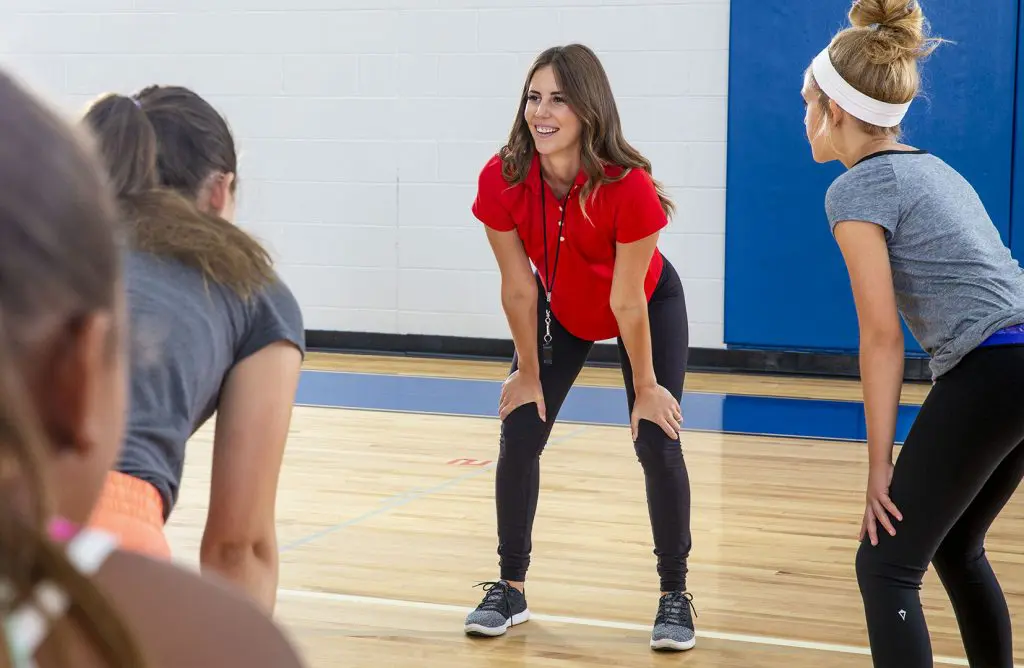
Have you ever finished a lesson and thought, “That was a great lesson, I am gooooood.” Or, “Wow! I might be in the wrong profession, that was awful.” Chances are classroom management was a driving force behind the quality of the lesson, good or bad. Here, classroom management will refer to teacher practices that enhance transitions, provide efficiency, and allow the teacher to nurture positive behaviors in physical education. In short, quality classroom management is a hallmark of an effective physical education lesson.
Tip 1: Starting and Stopping your PE Classes
First things first, successful teachers can stop and start their classes efficiently. I really struggled with this when I started teaching, but I learned a few tricks along the way. A consistent signal (whistle, “Freeze”) cues students to assume a predetermined position (I use hands on knees, eyes on me). Here are some more signal cue ideas using commands, echoes and sound effects. If equipment is in use, students place the equipment on the floor as to not be distracted. Once the signal is given teachers should scan the class to ensure 100% compliance within 5 seconds. Phrases like, “Wow, Faith had her hands on her knees before I finished the word freeze. Thanks! That’s what I am looking for” serve effective managers well. The video below shares a great example of how to start a class.
Tip 2: Group Management Strategies
Many activities in physical education have students working with a partner or small groups. While at one point I was determined that counting off was effective, I have learned otherwise. To make physical education efficient, routines for moving from an individual activity to a small group are essential. One strategy is to call out “Toe to Toe” or “groups of two”. This cues students to quickly find a partner. Rules such as “once you make eye contact that is your partner” and “if you take more than two steps come to the middle to find a partner” make grouping students efficient. Similarly, designating the center circle the “friendship spot” provides students a spot to find a friend.
Tip 3: Classroom Instruction: Shorter is Better
As a formerly long winded teacher, over the course of twenty years I have learned shorter is better. Concise, thorough, and thoughtful instructions allow me to maintain student attention and provide the necessary content. How can I say what I want to say but be brief? To help, the instruction typically includes “when” before “what”. “When I say ‘Go’, hustle to the green line and get a yarn ball to toss and catch in good spacing.” These short bouts (less than 30-45 seconds) increase student retention and maximize physical activity during physical education. Students are given small bouts of information and then allowed to practice. After students practice, the class can be frozen and another bit of information or skill cue provided. This process continues with activity interspersed with concise bouts of instruction.
Tip 4: How to Introduce Equipment to your PE Lesson
Equipment retrieval is often a time of inactivity, misbehavior, and frustration. To minimize these issues one strategy is to spread the equipment around the perimeter of the teaching area. This allows for swift retrieval, allows more activity, and decreases student frustration. When retrieving equipment, students should always be provided an activity to engage in once they have the equipment. Telling a student to hold on to a piece of equipment is inactive and asking for behavior problems.
While not an easy task, effective classroom management allows teachers to create a safe, non-threatening, structured environment. In turn, students can learn the joy of physical activity while moving. The teacher in the video below does an excellent job telling her students how to retrieve their equipment.





3 Responses
But there was no direction for retrieving the ball nor what to do next. Human target?
Information given in this blog post would be very useful for newbies who want to pursue their careers as physical education. Effective management skills are essential to improve the performance of the students. So, physical instructors should be aware of the basic aspects of management skills to get better control over the student in order to improve their performance.
Dr. Aaron,
I include this strategies in my sub plans, when working with new and experienced teachers, and even use them when leading large assemblies of students. And for those of us who are lucky to attend skilled professional development. I bet, you have seen these strategies in use.